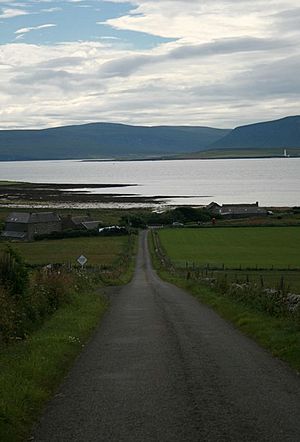Allison Balfour facts for kids
Allison Balfour, also known as Margaret Balfour, was a woman from the Orkney Islands in Scotland. She was accused of witchcraft in 1594, and her trial is one of the most famous witchcraft cases in Scottish history. At that time, a law called the Scottish Witchcraft Act of 1563 meant that if someone was found guilty of witchcraft, they could be put to death.
In 1594, the Orkney Islands were controlled by Patrick Stewart, 2nd Earl of Orkney, who was often called Black Patie. Patie believed that his younger brothers, especially John Stewart, Earl of Carrick, were planning to kill him. He found poison with one of John's servants, Thomas Paplay. Paplay was treated very harshly for eleven days until he confessed and said that Allison Balfour was also involved in the plot.
Even though Thomas Paplay later said his confession wasn't true just before he was executed, Allison Balfour and her family were taken to Kirkwall. There, they were also treated harshly until Allison confessed. She was then tried, found guilty of witchcraft, and sentenced to death. But just like Paplay, Allison Balfour said her confession was false right before she was executed on December 16, 1594. She publicly stated she was innocent and explained how she and her family had been forced to confess. She was executed at a place called Gallow Ha' in Kirkwall.
Contents
Witchcraft Beliefs in Orkney
The people of Orkney had long believed in different kinds of magic, witchcraft, and supernatural creatures. Magical powers were seen as a normal part of life and were not questioned.
Witch hunts began in Scotland around 1550. In 1563, the Scottish Parliament, led by Mary, Queen of Scots, passed a law that made witchcraft a crime punishable by death. Even though Orkney officially followed Norwegian law until 1611, Scotland had controlled the islands since 1468.
Black Patie's Rule
Patrick Stewart, 2nd Earl of Orkney, known as Black Patie, was in charge of the islands when the first witch trials happened in 1594. The Stewart family had many disagreements. Patie didn't get along with his father and especially disliked his younger brother, John Stewart. Patie was sure that John wanted to have him killed.
Patie found Thomas Paplay, John's servant, with poison. Paplay was put under extreme pressure for eleven days until he confessed. He named Allison Balfour as one of the people involved in the plot. However, Paplay later said his confession was not true just before he was executed.
Allison Balfour's Role
Not much information is available about witch trials in Orkney before 1612. However, Allison Balfour's case is one of the most well-known Scottish witchcraft cases. Allison Balfour lived in an area of Stenness called Ireland. She lived with her elderly husband, Taillifeir, and her children.
Allison was known as a natural healer and was respected for her knowledge. She had been asked for advice on how to cast a spell on Black Patie by his brothers and their friends, who were planning against him. These meetings supposedly started in October 1593, but it's not known what happened, and Black Patie didn't seem to suffer any harm. Despite this, Allison Balfour was arrested and taken to Kirkwall for trial in December 1594.
The Trial Process
Allison Balfour's case was unusual because it was started only by Patie's authority. Most Scottish witch trials needed official court approval. Many witch trials were held in St Magnus Cathedral, where prisoners might also have been kept. However, Balfour was held in Kirkwall Castle. Some historians believe that the harsh questioning might have happened in the cathedral. Allison Balfour was questioned for two days by Henry Colville, a minister and a close friend of Patie.
Execution and What Happened Next
Even though Colville had made a promise, Allison Balfour was found guilty of planning murder using witchcraft. She was sentenced to be put to death by hanging and burning. On December 16, 1594, Allison Balfour was taken to Gallow Ha' in Kirkwall for her execution.
Right before her sentence was carried out, people tried to make her say that Patrick Bellenden, the Laird of Stenhouse, was also involved. They asked her about a piece of wax found in her purse when she was arrested. They thought it was for making a doll to harm someone. But she denied their claims, saying it was for a treatment for Lady Bellenden's stomach pain.
Continued Family Conflict
The long-standing bad feelings between Patie and his brothers continued. On June 24, 1596, John Stewart, Earl of Carrick was accused in court in Edinburgh of planning with Allison Balfour to poison his brother, Patie. John Stewart defended himself by saying that the confession should be ignored because it was taken back and only obtained through harsh methods. He was found not guilty.
Colville continued to support Patie and became his deputy in 1595. Three weeks after John Stewart was found not guilty, Colville was in Nesting in Shetland on Patie's behalf. John Stewart and some friends, who also disliked Colville, sailed from Montrose to Shetland. They landed in Shetland and traveled to where Colville was staying. It's not clear who exactly "cruelly and unmercifully killed him" in July 1596. On October 14 that year, Stewart was tried for the murder and again found not guilty. William Stewart and Gilbert Pacock, two of John Stewart's employees, had already been executed for the crime.
See Also
- Isobel Gowdie
- Elspeth Reoch
- Witchcraft in Orkney


